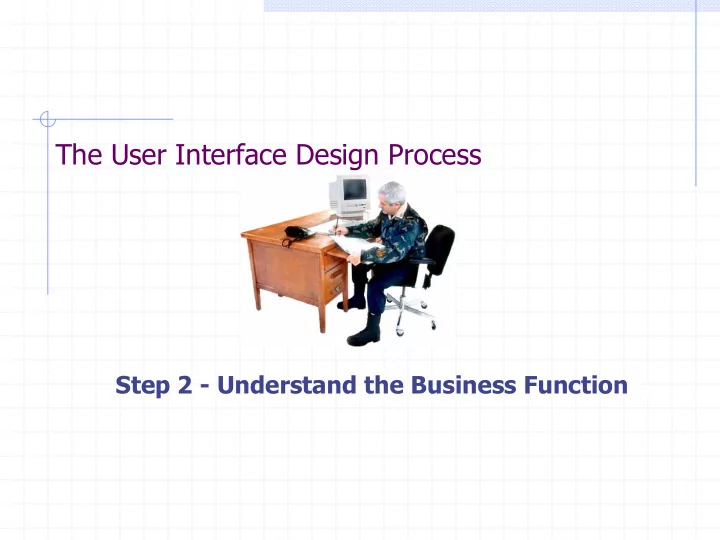

The User Interface Design Process Step 2 - Understand the Business Function
Step 2 - Understand the Business Function Introduction Business Definition and Requirements Analysis Requirements Collection Guidelines Determining Basic Business Functions Design Standards or Style Guides System Training and Documentation Needs
Introduction Understanding the application to be programmed is essential to success. The best program implementations come from first hand knowledge of the application and having worked in that field. Identifying all the special aspects of that application is necessary (Continued on Next Page)
Introduction (Continued) Each industry has special aspects: special data entry methods, access to unique calculations or tables, or specific processes. Sometimes it is tricky to identify these special needs A customer may be reluctant to divulge trade secrets (pricing, methods of calculation, etc.)
Business Definition and Requirements Analysis Direct Methods � Face to face meetings with, or actual viewing of, users to solicit requirements. Indirect Methods � Impose an intermediary, someone or something, between the users and the developers. The developer should be aware of the policies and work culture of the organization. The developer must also be familiar with any current system or process the new system is intended to supplement or replace.
Direct Methods Individual Face-to-Face interview Telephone Interview or Survey Traditional Focus Group Facilitated Team Workshop Observational Field Study Requirements Prototyping User-Interface Prototyping Usability Laboratory Testing Card Sorting for Web Sites
Indirect Methods MIS Intermediary Paper Survey or Questionnaire Electronic Survey or Questionnaire Electronic Focus Group Marketing and Sales Support Line (Continued on Next Page)
Indirect Methods (Continued) E-mail or Bulletin Board User Group Competitor Analyses Trade Show Other Media Analysis System Testing
Requirements Collection Guidelines: Establish 4 to 6 Different Developer-User Links � A developer link occurs when the developer contacts the user using one of the above methodologies. � For Custom Programs (In-house software) � For Packaged Products (Software for sale) Provide the Most Reliance on Direct Links
Custom Programs For Custom programs (developed for internal use and not for sale) � Facilitated Teams 5.0 � User-Interface Prototypes 4.0 � Requirements Prototype 3.6 � Interviews 3.5
Packaged Products For Packaged Products (software for sale) � Support Line 4.3 � Interviews 3.8 � User-Interface Prototype 3.3 � User Group 2.2
Determining Basic Business Functions Understanding the User’s Mental Model Developing Conceptual Models The User’s New Mental Model
Understanding the User’s Mental Model How users understand their task User’s needs User’s work preferences How they address the task Mental Models contain metaphors and objects Distill out these metaphors and objects to frame program
Developing Conceptual Models Guidelines for designing conceptual models Defining Objects (objects are things like change orders to contracts) Developing Metaphors
Guidelines for Designing Conceptual Models Reflect the user’s mental model, not the designer’s. Draw physical analogies or present metaphors. Comply with expectancies, habits, routines, and stereotypes. Provide action-response compatibility. Make invisible parts and process of a system visible. (Continued on Next Page)
Guidelines for Designing Conceptual Models (Continued) Provide proper and correct feedback. Avoid anything unnecessary or irrelevant. Provide design consistency. Provide documentation and a help system that will reinforce the conceptual model. Promote the development of both novice and expert mental models.
Defining Objects Determine all objects that have to be manipulated to get work done Identify the objects and actions that appear most often in the workflow Make the several most important objects very obvious and easy to manipulate
Developing Metaphors � Choose the analogy that works best for each object and its actions. � Use real-world metaphors. � Use simple metaphors. � Use common metaphors. � Multiple metaphors may coexist. � Use major metaphors, even if you can’t exactly replicate them visually. � Test the selected metaphors.
The User’s New Mental Model Program must accurately reflect mental model Program must easily move them to a new model if necessary Otherwise confusion, frustration, and decreased productivity result
Design Standards or Style Guides Design standards provide value for both the user and the developers Business System Interface Standards and Guidelines Web Guidelines and Style Guides Designing the Style Guide Document
System Training and Documentation Needs Training is necessary for most programs Documentation is important
Recommend
More recommend